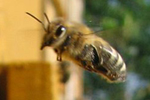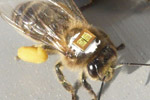A widely used insect nerve agent has been labelled a “high acute risk” to honeybees by the European Food Safety Authority (EFSA). A similar assessment by the EFSA on three other insecticides preceded the suspension of their use in the European Union.
“The insecticide fipronil poses a high acute risk to honeybees when used as a seed treatment for maize,” the EFSA said in a statement. “EFSA was asked to perform a risk assessment of fipronil [by the European commission], paying particular regard to the acute and chronic effects on colony survival and development and the effects of sub-lethal doses on bee mortality and behavior.”
Fipronil, manufactured by the German chemical company BASF, is used in more than 70 countries and on more than 100 different crops, as well as for cockroach and termite control. The EFSA report found the risk to honeybees from drifting pesticide dust was high when fipronil was used as a seed treatment for maize, but did not have the data to assess the risk from its use on sunflowers, or the risk via pollen and nectar, or the risk to other bees and pollinators.
Scientific evidence that common pesticides are harming bees has risen in the last year and, along with huge public protests, culminated in the European commission (EC) imposing the ban on three neonicotinoids. Bees and other insects pollinate three-quarters of the world’s food crops but have suffered steep declines due to habitat loss, disease and pesticide use.
“The EC needs to seriously look at the fipronil case, and whether it warrants similar restrictions,” said MEP Glenis Willmott, Labour’s leader in the European parliament. “I think there are grounds for the commission to step in. I hope that when evaluating this and other potential risks to honeybees the UK government will play a more constructive role than before, after defying scientific advice and public opinion in the neonicotinoid case.” The UK was one of eight out of the 27 EU member states that unsuccessfully opposed the EC neonicotinoid ban.
“Our business is very dependent on bees; therefore, it is in our best interest to understand the real causes of the decline in bee health and act upon them”, said Jürgen Oldeweme, senior vice-president for BASF’s crop protection division. “The problem of declining bee health must be addressed via a holistic approach and not by singling out certain technologies that have a solid record of safe use, such as fipronil.”
But green campaigners said the EFSA report showed current EU regulation of pesticides was not sufficient. “The fact that fipronil and other pesticides toxic to bees were authorized at all shows that EU safety testing is in dire need of an overhaul,” said Marco Contiero, Greenpeace EU agriculture policy director. “These pesticides have been building up in our environment for a decade, so limited, temporary bans won’t be enough to give bees a breather. The commission should develop a comprehensive plan for the protection of insect pollinators, starting with a solid ban on fipronil and other bee-harming substances.”
Dr Friedhelm Schmider, director general of the European Crop Protection Association, which represents the chemical industry, said any ban might affect food production: “We plead with regulators to take into account all elements and consider the potential impact on agriculture that any decision might have. We are fully committed to work on proportionate measures managing any possible risk from pesticides.”

Honey bee (Apis mellifera) collecting pollen. Photo by: Jon Sullivan/Public Domain.
Original Post:
Fipronil named as fourth insecticide to pose risk to honeybees
Related articles
U.S. loses nearly a third of its honey bees this season

(05/09/2013) Nearly a third of managed honeybee colonies in America died out or disappeared over the winter, an annual survey found on Wednesday. The decline—which was far worse than the winter before—threatens the survival of some bee colonies. The heavy losses of pollinators also threatens the country’s food supply, researchers said. The US Department of Agriculture has estimated that honeybees contribute some $20bn to the economy every year.
Europe bans pesticides linked to bee collapse
(04/29/2013) The EU has banned three neonicotinoid pesticides (imidacloprid, clothianidin and thiamethoxam) linked to the decline of bees for two years. The ban will apply to all flowering crops, such as corn, rape seed, and sunflowers. The move follows a flood of recent studies, some high-profile, that have linked neonicotinoid pesticides, which employ nicotine-like chemicals, to the widespread decline of bees seen both in Europe and North America.
Domesticated bees do not replace declining wild insects as agricultural pollinators

(04/03/2013) Sprinkled with pollen, buzzing bees fly from one blossom to another, collecting sweet nectar from brilliantly colored flowers. Bees tend to symbolize the pollination process, but there are many wild insects that carry out the same function. Unfortunately, wild insect populations are in decline, and, according to a recent study, adding more honey bees may not be a viable solution.
Common pesticides disrupt brain functioning in bees
(03/27/2013) Exposure to commonly used pesticides directly disrupts brain functioning in bees, according to new research in Nature. While the study is the first to record that popular pesticides directly injure bee brain physiology, it adds to a slew of recent studies showing that pesticides, especially neonicotinoids, are capable of devastating bee hives and may be, at least, partly responsible for on-going Colony Collapse Disorder (CCD).
EU pushes ban on pesticides linked to bee downfall

(02/05/2013) Following a flood of damning research on the longterm impact of neonicotinoid pesticides on bee colonies, the EU is proposing a two year ban on the popular pesticides for crops that attract bees, such as corn, sunflower, oil seed rape, cotton. The proposal comes shortly after European Food Safety Authority (EFSA) released a report that found neonicotinoid pesticides posed a “number of risks” to bees.
New study adds to evidence that common pesticides decimating bee colonies

(10/24/2012) The evidence that common pesticides may be partly to blame for a decline in bees keeps piling up. Several recent studies have shown that pesticides known as “neonicotinoid” may cause various long-term impacts on bee colonies, including fewer queens, foraging bees losing their way, and in some cases total hive collapse. The studies have been so convincing that recently France banned the use of neonicotinoid pesticides. Now a new study finds further evidence of harm caused by pesticides, including that bees who are exposed to more than one chemical, i.e. neonicotinoid and pyrethroid, were the most vulnerable.
After damning research, France proposes banning pesticide linked to bee collapse
(06/04/2012) Following research linking neonicotinoid pesticides to the decline in bee populations, France has announced it plans to ban Cruiser OSR, an insecticide produced by Sygenta. Recent studies, including one in France, have shown that neonicotinoid pesticides likely hurt bees’ ability to navigate, potentially devastating hives. France has said it will give Sygenta two weeks to prove the pesticide is not linked to the bee decline, known as Colony Collapse Disorder (CCD).
Researchers recreate bee collapse with pesticide-laced corn syrup

(04/05/2012) Scientists with the Harvard School of Public Health (HSPH) have re-created the mysterious Colony Collapse Disorder in several honeybee hives simply by giving them small doses of a popular pesticide, imidacloprid. Bee populations have been dying mysteriously throughout North America and Europe since 2006, but the cause behind the decline, known as Colony Collapse Disorder, has eluded scientists. However, coming on the heels of two studies published last week in Science that linked bee declines to neonicotinoid pesticides, of which imidacloprid is one, the new study adds more evidence that the major player behind Colony Collapse Disorder is not disease, or mites, but pesticides that began to be widely used in the 1990s.
Smoking gun for bee collapse? popular pesticides

(03/29/2012) Commonly used pesticides may be a primary driver of the collapsing bee populations, finds two new studies in Science. The studies, one focused on honeybees and the other on bumblebees, found that even small doses of these pesticides, which target insect’s central nervous system, impact bee behavior and, ultimately, their survival. The studies may have far-reaching repercussions for the regulation of agricultural chemicals, known as neonicotinoid insecticides, that have been in use since the 1990s.







